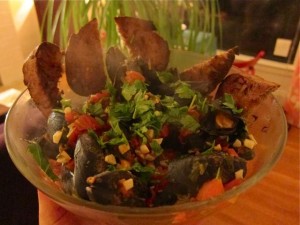This burger made of millet and edamame is a nutritious and planet-friendly alternative to ground beef. Using carrot peels as a topping also helps to avoid unnecessary food waste.

Blog: Low Carbon Diet
+ Blog Categories

A Hot New Twist on Low Carbon Diet Day
- Blog
Food can be a terrific vehicle to use for educating people about complex topics, and luckily, I work for a company that has an army of chefs who enjoy just this kind of challenge. Bon Appétit was the first food service company to address food’s role in climate change, and every year around Earth Day, our chefs change their menus and explain to their diners at corporations, colleges and universities, and museums in 32 states how their every day food choices affect our planet. For Earth Day today, we’re doing something a little different. Our chefs are standing in front of guests at a cooking demonstration table, making almond-milk-fruit smoothies, cheeseless pizzas, and edamame burgers with carrot peel toppings. They’re talking about how climate change isn’t just this storm gathering way down the road, it’s here and it’s affecting some of our favorite foods.

Wasting Food is Not Sustainable
- Blog
In the United States, 40% of food goes uneaten. Just so we’re clear, that’s nearly half. Yet one in every six Americans lacks a secure supply of food. Waste is happening at every part of the supply chain: thousands of pounds of fresh vegetables are being left in the fields to rot, blemished produce are being tossed at our supermarkets, restaurants are dumping perfectly good leftovers, and consumers are letting food waste away in their refrigerators. Clearly, we have a problem.

Why We Need a More Resilient Food System
The drought that struck the United States this year stunted growth of field corn and soy, and as a result, 2013 will be the first time in 38 years where annual beef, pork, and chicken output all decline. We need a resilient food system that can cope with a changing climate and unpredictable conditions such as this drought. How are we going to get there?

Looking at Our Initiatives From the Other Side of the World
- Blog
This year I went trekking in the Himalayas of Nepal. Here are a few of the things I witnessed and how the experience sometimes turned my views on our sustainability commitments on their side.

A Shocking Display Gets University of Redlands To Think Twice About Disposables
- Blog
Students at the University of Redlands spend a week each semester to host fun activities that raise environmental awareness and inspire action on campus. The most recent Green Week coincided with Food Day so Bon Appétit was invited to co-host an event with a coalition of environmental organizations that focused on waste and the food system. Students and staff strung 1,050 disposable to-go boxes around Hunsaker Plaza to show people how much ends up in the landfill every day on campus and the students asked people to pledge to only use to-go boxes when actually on the go.
The idea for the event was conceived when students learned that on average 5,250 disposable to-go boxes end up in the landfill each week and approximately $25,000 is spent on those boxes each semester!

Thomas Keller Has a Responsibility — to Set the Record Straight
I was surprised and disheartened to read comments by Thomas Keller in the New York Times that chefs’ only responsibility is to taste. “Is global food policy truly our responsibility, or in our control?” Keller asks. “I don’t think so.” I disagree, as do many others, and I am hoping that Keller’s statements were taken out of context. Chefs have an enormous power to make a difference, and they can do so without sacrificing flavor.

Fava Bean and Fresh Mint Spread
- Blog
This month’s Well Being Challenge encourages you to choose a healthy meal that also meets a low carbon principle for at least one meal each day this month. To get started, try the below recipe that meets the seasonal and regional low carbon principle. To learn more about the nutrition principles of a low carbon diet, visit cafebonappetit.com

How Low Carbon Can You Go? We Can Help!
- Blog
These days, you can’t walk into a grocery store without being exposed to a new diet: flexitarian, vegetarian, vegan, paleo, cookie diet, low-fat, cabbage soup, gluten-free, elimination, low carb…the list goes on.
But there’s one important diet that most people have never considered: the low carbon diet. Shrinking our carbon “foodprint” is just as important as shrinking our waistlines. The food system — from fertilizers to livestock, transportation, and packaging — is responsible for at least one-third of global greenhouse gas emissions.

Mussels in Spicy Tomato-Cilantro Broth
- Blog
This month’s Well Being Challenge encourages you to choose a healthy meal that also meets a low carbon principle for at least one meal each day this month. To get started, try the below recipe that includes a ‘super green’ seafood according to the Monterey Bay Aquarium’s Seafood Watch program. To learn more about the nutrition principles of a low carbon diet, visit cafebonappetit.com
